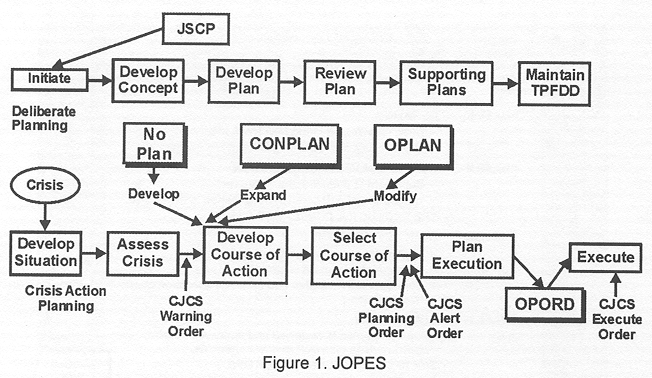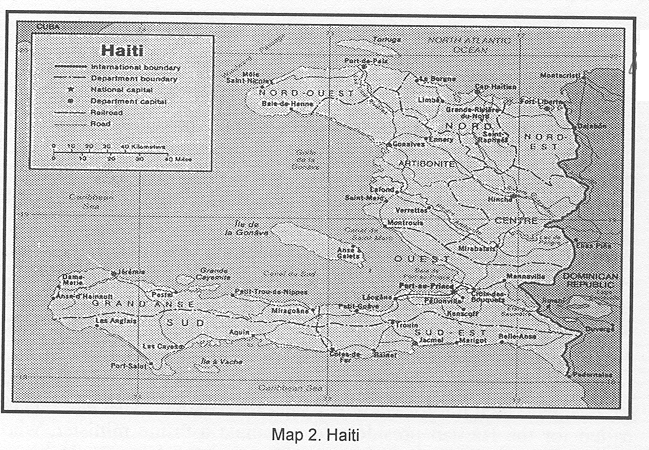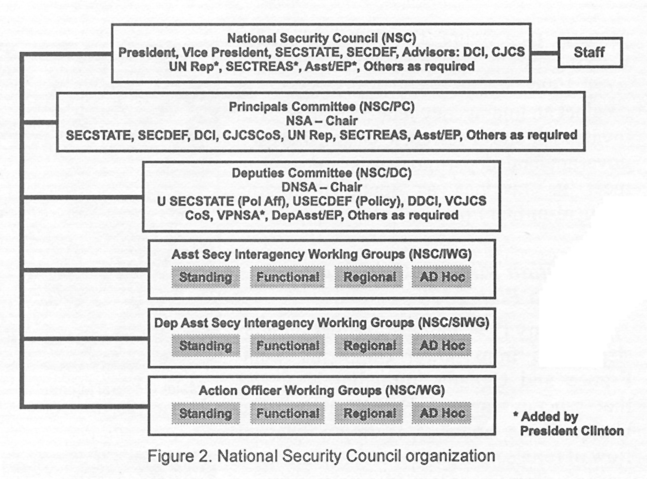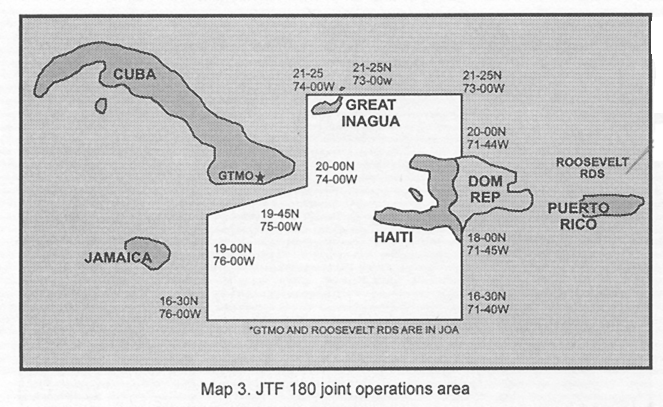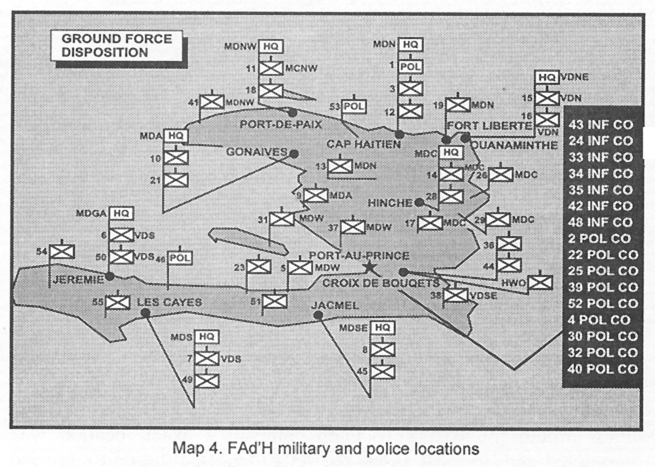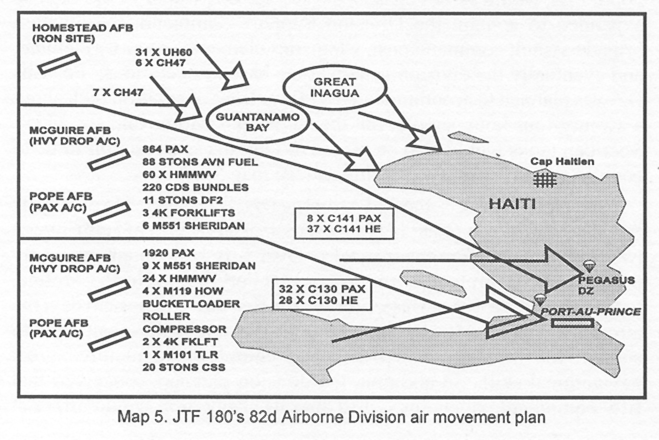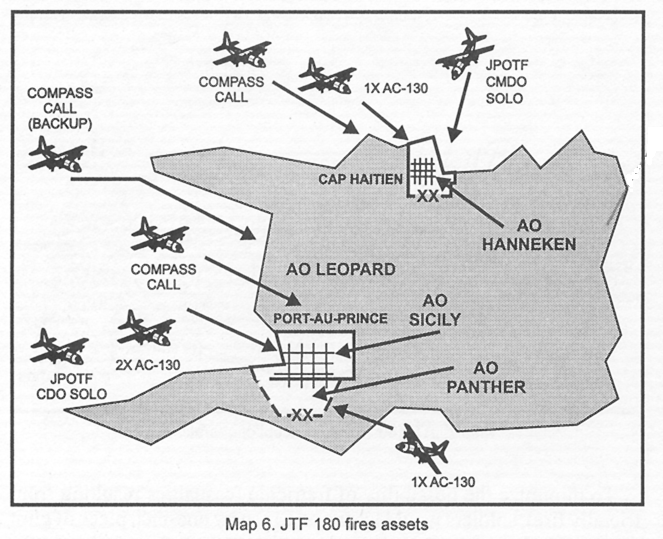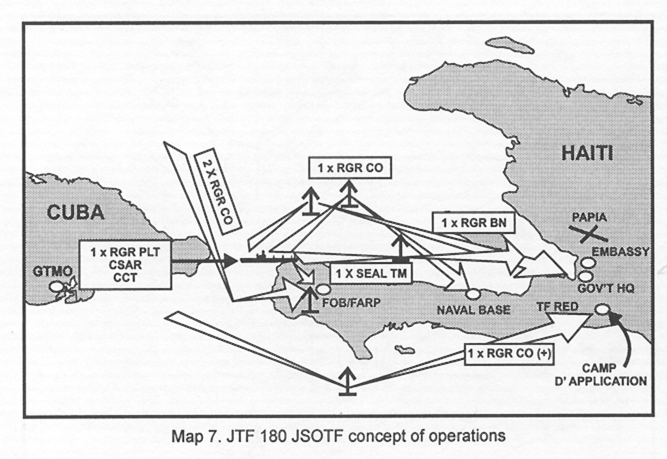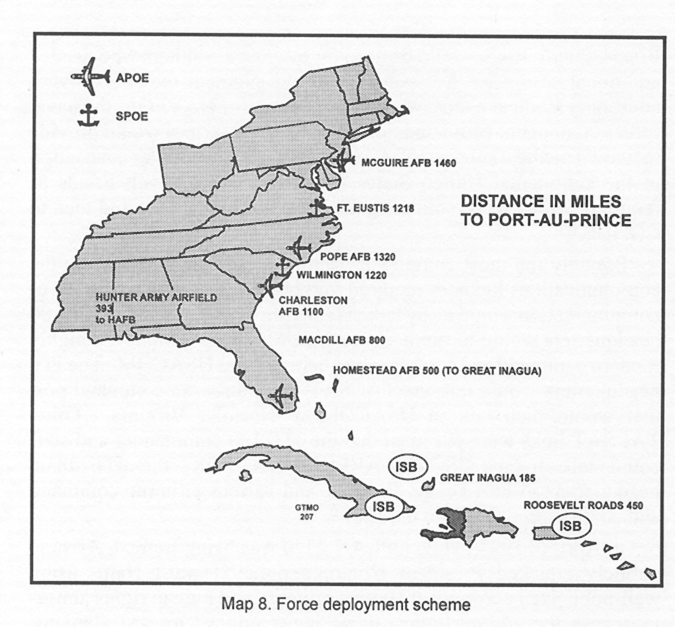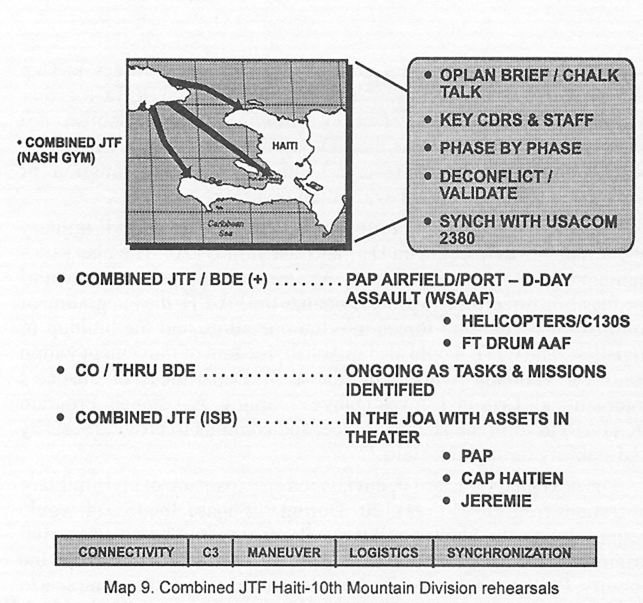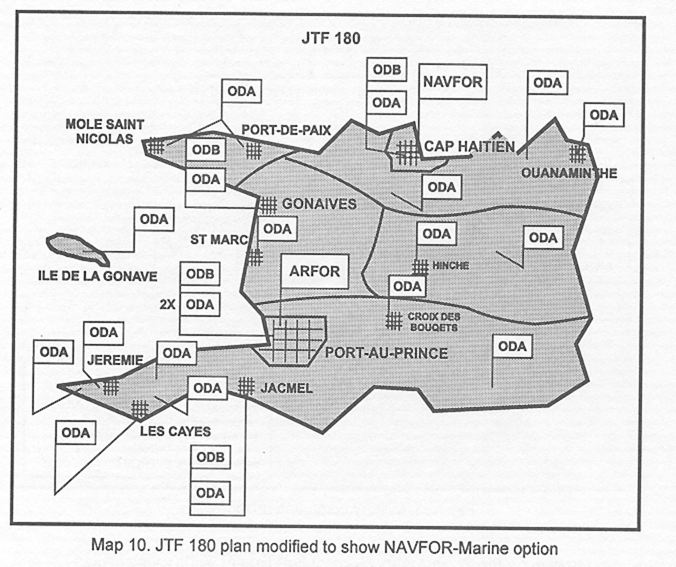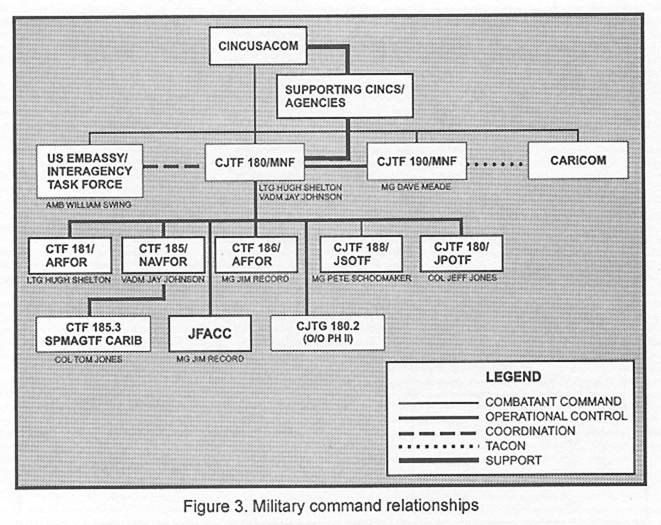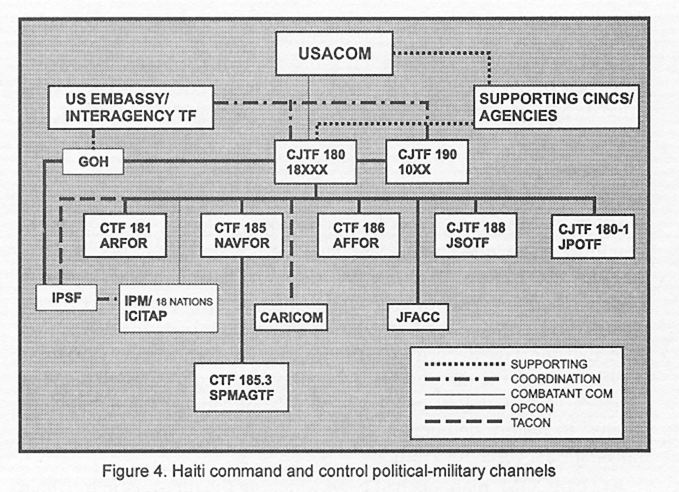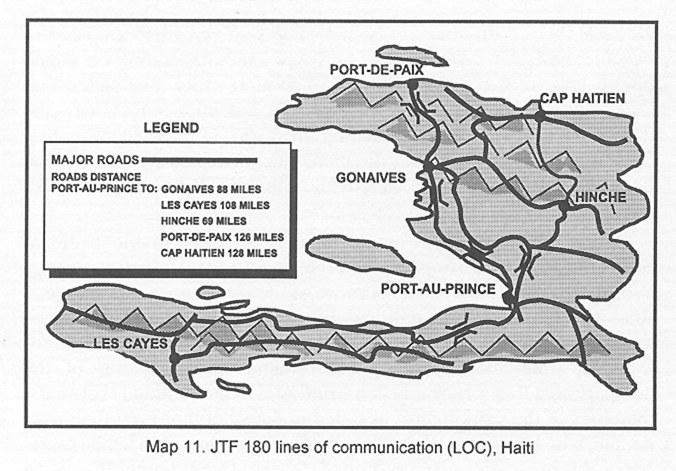|
Planning for "Intervasion": The Strategic and Operational Setting for Uphold Democracy Walter E. Kretchik The key to this operation is synchronicity, and violence of action with spontaneity and simultaneity. -Anonymous Uphold Democracy plans officer1 At the time, peace operations fell under the LIC umbrella. By the mid-nineties, they had become one subset of a new category, operations other than war. Regardless of these shifts in doctrinal labels, peace operations have traditionally confronted the U.S. military with a variety of situations in which the use of force was either a distinct possibility (as in peace enforcement or peace keeping), or very unlikely (as in disaster relief or humanitarian assistance). Furthermore, since peace operations are often guided by the United Nations or some regional organization, the commitment of American troops to a multinational undertaking is often accompanied by a heated dialogue over who should exercise command and control over them--U.S. or foreign officers. Also a topic of perennial debate with respect to peace operations has been how the U.S. military community should best train and prepare its units for such undertakings. Peace operations, as opposed to more orthodox military operations, often lack a traditional enemy, tend to be highly ambiguous, and are subject to frequently changing political guidance. Because of these patterns, some senior military leaders have argued that certain U.S. military units should be trained purely in peace operations instead of conventional combat. Other, more traditionalist-minded officers have responded that the role of the U.S. military remains unchanged: to fight and win America's conventional wars. To these officers, a peace operation is nothing more than a special mission requiring only specific training prior to the commitment of troops. Moreover, they contend, traditional training is essential for a shrinking military that, still burdened with global security responsibilities, must be ready to deploy anywhere to fight a conventional conflict deemed to be in the national interest. Thus far in the debate, the traditional thinkers have prevailed. The Defense Planning System The peace operation launched in Haiti in 1994 would employ conventional units with Special Operations Forces (SOF). The policy they would implement had evolved over many months, during which time U.S. staff officers used the Defense Planning System to formulate the military plans that eventually became Operation Uphold Democracy. That planning system, also known as the Joint Operations Planning and Execution System (JOPES), was and remains the prescribed method for military planning at the strategic and operational level (see figure 1).3 There are two strategic-operational planning options within JOPES: (1) deliberate or peacetime planning and (2) time-sensitive or crisis-action planning (CAP).4 Deliberate planning is used to develop plans when concerns about time are not urgent (see table 2). Most of Operation Uphold Democracy, however, was planned using CAP, the option reserved for crises in which time is a critical factor. CAP calls on combatant cornmanders in chief (CINCs) to formulate and transmit executable courses of action up the chain of command for consideration by the National Command Authority (NCA). Once the NCA has decided on a course of action, the appropriate CINC may be ordered to implement the decision. The CAP process has six phases, any two or more of which may happen sequentially or simultaneously.
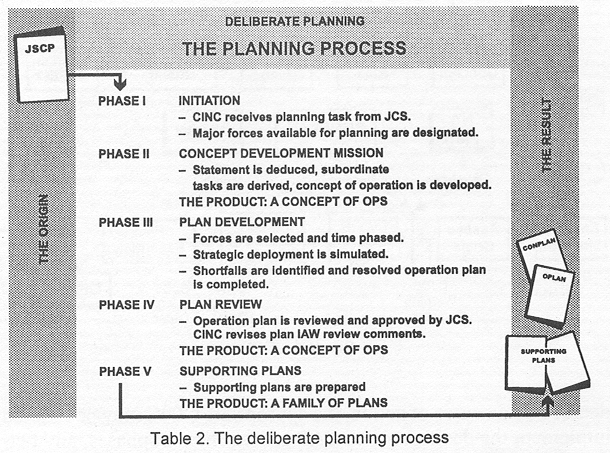 Generally speaking, operations plans formulated under the deliberate planning system are written within the Strategic Plans and Policy section of a headquarters staff. Normally, that staff section is identified as joint operations, or J5, if more than one U.S. military service is involved, or as combined operations, or C5, if foreign officers work alongside their U.S. counterparts. Once a plan is written and approved, it can be set aside until given for execution to the Current Operations staff section, which would be the J3 in the operations and planning cell of the joint staff, the C3 in a combined staff.5 Under crisis-action conditions, however, planning is normally performed by J3 or C3, rather than the J5 or CS. The United States Army Decision-Making Process Once a plan is conceived at the operational level, it is provided to a headquarters at the tactical level for further refinement. The U.S. Army endorses a standardized, tactical decision-making process that serves as a methodology for guiding tactical commanders and their staffs in the development of operational plans and orders. Army Field Manual 101-5, Staff Organization and Operations, is the primary doctrinal source that describes the tactical decision-making process, which consists of four steps.
Initial Planning In September 1991, while the Pentagon contended with internal change and a rapidly shifting international environment, the primary focus of U.S. military planning for the deteriorating situation in Haiti was on the possible evacuation of American citizens and selected third-party foreign nationals to the United States or other designated safe havens. The 82d Airborne Division, a subordinate unit to XVIII Airborne Corps, promised to be the primary force to enter Haiti if an evacuation were required.6 From September 1991 until February 1992, the 82d staff at Fort Bragg, North Carolina, dusted off and revised an early 1980s plan, designated Contingency Plan (CONPLAN) 2367, calling for a noncombatant evacuation operation (NEO) in Haiti.7 The plan encompassed several options, each corresponding to a perceived level of threat. The option calling for the use of the airborne division postulated a forcible entry into Haiti, with an expected ten-day NEO to extract up to ten thousand noncombatants. The 82d was not the only headquarters working on a plan for the immediate crisis. At Norfolk, the U.S. Atlantic Command (USACOM) also had a NEO option for Haiti, one in which U.S. Marines staging at Guantanamo Bay would seize an airfield in Haiti and use it to conduct a more permissive or noncontested NEO (see map 2). In February 1992, the urgency for planning a NEO into Haiti diminished, and the USACOM plan was shelved.8 But as the crisis in Haiti continued into 1993, USACOM monitored the deteriorating situation. The Governors Island Agreement In February of 1993, the junta that had ousted President Aristide denied the deployment of international human rights observers to monitor conditions in Haiti. As explained by Haitian strongman Lieutenant General Raoul Cedras, the observers could enter the country only if certain conditions were met, including international recognition of the junta-backed government of Prime Minister Marc Bazin and the lifting of the economic embargo. When United Nations (UN) negotiator Dante Caputo arrived in Haiti to work out an arrangement, he was met by demonstrations and insults. A frustrated Caputo eventually left the country under escort to protect him from possible mob violence. On a more positive note, continued international pressure did eventually convince Cedras to allow the observers into Haiti. In the United States, President Bill Clinton in March 1993 declared his intention to restore Aristide to power and to rebuild the Haitian economy. Following this, Caputo again notified the Haitian junta that they should relinquish power. In April 1993, Cedras agreed to resign in exchange for amnesty for himself, his family, and members of his staff. Aristide, in exile, agreed to those conditions.9 When Caputo returned to Haiti in April 1993, however, he met more resistance from the Haitian junta. In effect, Cedras and his henchmen did not trust Aristide, nor did they believe that the UN or the United States would follow up on threats to impose more economic sanctions. As Donald Schulz and Gabriel Marcella put it: [Domestic] pressure on the Clinton administration to take stronger action to resolve the refugee problem had lessened as a result of the president's decision to continue his predecessor's policy of forcible repatriation. The obvious reluctance of Washington and its allies to intervene militarily or even to substantially tighten the embargo . . . gave hope to the Haitian rulers that, when push came to shove, their foreign advisors would back off.10
On July 3, the Governors Island Agreement was signed, first by Cedras, who then left for Haiti, and later by Aristide. That agreement called for the Haitian president to nominate a prime minister, who would be confirmed by the Haitian parliament. Furthermore, Haitians who participated in the 1991 coup would receive amnesty, Cedras would retire, and international sanctions imposed under United Nations Security Council Resolution (UNSCR) 841 would be lifted. Aristide would then return to Haiti on October 30, 1993. Most important, the accord allowed for UN military forces and police personnel to enter Haiti, prior to Aristide's return, to train the Haitian police and army and to help rebuild the nation's shattered infrastructure. If implemented, the accord promised to ease if not end Haiti's internal crisis, not to mention its political fallout in the United States. There were those at the time, however, including planners at USACOM and Fort Bragg, who believed that the recently agreed-to accord might be unenforceable.11 Soon after the Governors Island Agreement was signed, Haiti underwent its worst period of violence since the 1991 coup. Hundreds of Haitians were killed or disappeared, while pro-Aristide activists were beaten, intimidated, or arrested, often in front of UN observers. Numerous corpses turned up on the doorstep of hotels where UN observers lived, and gunfire was a daily occurrence.12 Instead of preparing his departure from office, Cedras was consolidating his power by eliminating all potential rivals, to include staunch supporters of Aristide. The Harlan County Debacle In August 1993, USACOM, at the direction of the Joint Staff, created the Joint Task Force Haiti Assistance Group (JTF HAG) and named Colonel J. G. Pulley, then commander of the 7th Special Forces Group at Fort Bragg, as the commander. JTF HAG was an ad hoc organization whose personnel ranged from various subject-matter experts on Haiti to officers who knew nothing about the country and its problems. Many assigned to the JTF had little idea of what they were expected to do. One such individual was U.S. Army Lieutenant Colonel Phil Baker, then a military history instructor at Fort Leavenworth, Kansas. As JTF HAG was being stood up, Baker was notified to deploy from the classroom to Norfolk, Virginia, within twenty-four hours. En route, he stopped off at the Army's Training and Doctrine Command (TRADOC) at Fort Monroe, Virginia, where in a briefing session with Major General Carl Ernst he, for the first time, received some indication of his mission. Ernst essentially told Baker that he would be heading a team to professionalize and train the Armed Forces of Haiti (FAd'H) and, as Baker recalled, to "do good things as a representative of the United States Army."13 Upon arriving in Norfolk, Baker was told that he would not be in charge of the entire professionalization program, but that he was to develop a plan to professionalize and train the Haitian Army staff. He then went to the HAG planning cell where he observed, Everything was in chaos. Planners from all services were thrown together trying to figure out what they were doing without much organization. Lots of people were just doing what they thought they needed to do; what they were comfortable with whether or not it had anything to do with the plan. Everybody at least looked busy. In the middle of this chaos was a Marine lieutenant colonel under a lot of pressure trying to produce an operations order. I remember that chairs were scarce; if you left yours for even a second, someone stole it.14Pulley eventually met with his principal staff at the base officers' club where he laid out his plans for the HAG. The colonel directed his staff to plan for separating the Haitian Police from the military, and then for reforming and professionalizing the FAd'H. As the staff tried to figure out what was meant by "professionalizing" the Haitian military, they received information that the Haitians did not want such training anyway. Lieutenant Colonel Mike Jones, a Special Forces commander and the leader of the Haiti site survey party that went ahead of the HAG, notified the JTF on September 16, 1993, that the Haitian Army believed that they were already professional and, instead, wanted new equipment and marksmanship training. 15 Throughout the month of September, while the HAG continued to plan, Haitians were subjected to more regime-sponsored acts of violence. Five people were killed, and many others wounded in a Port-au-Prince riot originating from Mayor Evans Paul returning to office after his ouster in 1991. On September 11, Antoine lzmery, a strong Aristide supporter, was assassinated. Numerous Haitian officials were threatened with personal violence, and the U.S. Embassy had its electricity cut off.16 As the violence escalated, the UN Security Council on September 23 authorized the sending of 1,267 police and military personnel into Haiti in accordance with the Governors Island Agreement.17 By the end of September, two U.S. Navy ships were ready to transport the HAG to Haiti. The USS Harlan County would depart first with 225 UN observers, followed later by the USS Fairfax County. The Harlan County departure was anything but smooth. USACOM provided few instructions for embarkation and departure. Therefore, JTF HAG personnel boarded the ship in dribbles over a twenty-four-hour period, with many members arriving late at night. Lieutenant Colonel Baker was standing around with other personnel preparing to board the ship when a "Navy officer, the ship's executive officer, wanted to know who was in charge of the boarding troops. Everyone looked around or at their feet. I noticed that I was the senior officer so I said that I guess I was. The executive officer then asked for a manifest, a list of equipment, copies of orders, and other administrative paperwork. I stared at him because no one had thought about any of that stuff."18 Baker immediately found the senior noncommissioned officer and an Army captain, whom he appointed as his first sergeant and executive officer, respectively. They then began the laborious process of accounting for personnel, most of whom belonged to U.S. Army Special Forces and a U.S. Marine Corps military police platoon. A Marine warrant officer, "Gunner" Hayes, loaded every piece of equipment he could find as efficiently as time and space allowed. The Harlan County departed the next morning as a Navy doctor ran up the gangway and threw himself and his gear aboard. In addition to the personnel accountability problem, a command situation existed that would later prove significant. Neither the Harlan County, commanded by U.S. Navy Commander Marvin E. Butcher, or the Fairfax County was part of JTF HAG or subordinate to it during the movement to Haiti. Butcher took his orders not from Colonel Pulley but from USACOM through the Commander in Chief, Atlantic Fleet (CINCLANTFLT).19 Butcher's mission was to transport the JTF to Haiti, then provide berthing and life support to the embarked troops until they moved onto the dock. Once completely ashore, the troops would come under the command of Colonel Pulley, who had flown ahead and would meet the ship in Port-au-Prince. Upon leaving Norfolk, the Harlan County stopped at Roosevelt Roads, Puerto Rico, to embark a U.S. Navy construction battalion as well as Canadian engineers. The scheduled departure from Puerto Rico was then delayed as events in Haiti became more violent. The United Nations Security Council resolution did not call for a forced entry into the country, and despite the increase in violence there, U.S. military personnel continued to view the situation in Haiti as a permissive one. According to Baker, "We were suppose to do the high vis[ibility] things, the medical and construction and humanitarian things, with the intention of showing the Haitians that Aristide was returning, and look at the money he's bringing back; hey, this is a good deal."20 On October 3,1993, while the Harlan County was preparing to move to Haiti, eighteen U.S. Army soldiers, many of them Rangers, were killed in Somalia in support of the UN-directed mission, Restore Hope. Thirty-one other soldiers were injured.21 News of the firefight, accompanied by the Cable News Network's (CNN) graphic images of dead American troops being dragged through the streets of Mogadishu by Somali gunmen, shocked the American public and their political and military leaders. As Shulz and Marcella note: The incident ... [intensified] U.S. fears of further involvement in UN peacekeeping operations. By now, the Pentagon was leery of becoming involved in Haiti.... DOD planners sensed, quite correctly, that the small, lightly armed international force that was scheduled to go into the country would be incapable of preventing violence.... This was a prescription for disaster and led to an unseemly spate of public bickering between State and Defense Departments.22The Haitian junta, meanwhile, followed news coverage of the debates precipitated by the firefight and concluded that "[T]he United States was weak and irresolute. If the Americans could be persuaded that Haiti was another Somalia, the Clinton administration would be forced to back down."23 Consequently, Cedras began to plan a public demonstration that would seek to intimidate JTF HAG and discredit both the UN mission and the United States. By then, the Harlan County was steaming toward Port-au-Prince with its multinational forces feverishly sewing on UN patches, while Lieutenant Colonel Baker taught a class on how to properly wear blue berets. Commander Butcher was informed that Colonel Pulley intended to host a reception for local Haitian dignitaries aboard his ship on arrival, as a peaceful gesture. Butcher balked, noting that Navy regulations forbid the inspection of warships by foreign citizens. Butcher, moreover, noted that the less the Haitians knew about his ship, the more respect they would have for it. To accommodate Pulley, however, Butcher agreed to a topside deck tour, with Haitians under close escort. The Harlan County arrived in Port-au-Prince at 0200 on Monday, October 11, 1993. Butcher discovered amaze of ships anchored around the harbor approaches in what appeared to be a deliberate attempt to slow access to the port. The commander safely negotiated his way around the ships and dropped anchor at 0500. As he did so, he noticed that the Haitian police were forcing civilian work crews off the merchant ships at pier side.24 Butcher sought to berth his ship but found that an old Cuban tanker was occupying his mooring. Without a clear space to maneuver his ship, Butcher decided to launch a small LCPL (landing craft personnel [large]) to assess the situation.25 He, along with "Gunner" Hayes and a U.S. Army Special Forces major, came within fifty feet of the pier, where they saw a group of Haitian policemen but little other activity. A U.S. Coast Guard commander actually reached the pier but informed the Harlan County that he was leaving due to gunfire. Butcher could hear gunfire as well, although he was not fired upon. The planning assumption of a permissive entry, at least in Butcher's mind, was now in question.26 Butcher returned to his ship and reported his situation to CINCLANTFLT. He then directed all JTF personnel to go to their rooms and wait. In the harbor, several Haitian boats, some flying the flag of the "Tonton Macoute" (the secret police of the Duvalier era), circled the ship. Butcher ordered his crew to man the ship's caliber .50 machine guns, after which the Haitian boats beat a hasty retreat. Meanwhile, Ms. Nikki Huddleston, the U.S. charge d'affaires in Haiti, was observing the Harlan County from the balcony of the Montana Hotel with, among others, Colonel Pulley and Dr. Bryant Freeman, a specialist on Haiti from the University of Kansas. When Huddleston heard about the situation in the harbor, she decided to go to the port area in an attempt to fix the problem.27 Pulley advised her not to make the trip. At 0700 that morning, he had witnessed about forty Haitians arriving at the dock by bus. He had then watched as the group drank free liquor and worked themselves into a frenzy, while some fired weapons into the air and chanted anti-American slogans. He further observed the Haitians drag two corpses off the bus and throw them into the middle of the demonstration. Despite the horror of the scene, Pulley saw that the demonstrators were separated from the pier by a fourteen-foot-high fence and a masonry wall. In his opinion, the unruly mob was loud but disorganized and posed little threat to the troops aboard the Harlan County.28 Huddleston considered the colonel's warnings but decided to go to the dock area anyway. She arrived on the scene in her armored sedan to discover that the gate to the port was locked and that the key was nowhere to be found. Moreover, the drunken Haitians, in essence a mob being goaded and paid by the Revolutionary Front for Haitian Advancement and Progress (FRAPH), were chanting "Remember Somalia!"29 Recognizing Huddleston, they began to beat on her car with ax handles. Although there was little chance of the charge being injured or her car immobilized, the live video CNN ran of her reluctant retreat from the port area created a different impression. 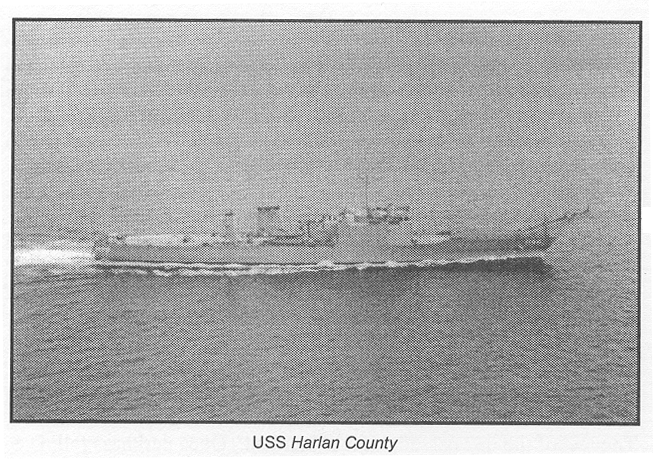 Butcher, from aboard his ship, was in a three-way telephone conversation with Pulley and a USACOM representative in Norfolk. Pulley continued to maintain that although the situation was tense, the environment, in his mind, was still permissive. Butcher disagreed and
expressed strong concern over what he believed were gunshots from the pier. When Pulley insisted that the mob would run off if challenged, Butcher offered to land a contingent of armed U.S. Marines to intimidate the crowd. The available Marines, however, had already
donned UN blue berets and soldier patches and had had their vehicles painted white, with a large "UN" prominently displayed on each. Any landing force would thus be acting under the auspices of the United
Nations, and violence was the one thing that the UN wanted to avoid.30 Moreover, the USACOM representative, well aware of the recent Somalia disaster, advised Pulley that any American casualties would be unacceptable. Pulley had little to say in the matter, as his troops were aboard the Harlan County and not under his command until they came ashore. Later that day, Haitian patrol boats circled the American ship but remained well clear when they noticed that the guns were manned. The rest of the day passed without incident. Once darkness fell, U.S. Special Forces and intelligence personnel aboard the ship did what they could to reconnoiter the shore. At one point, the Haitians had several cars park in a line along the shore and shine their headlights on the Harlan County. At another point, the Americans aboard ship, using night-vision devices, observed what they believed to be two V-150 armored personnel carriers with 90-mm guns hidden behind the pier.31 Butcher knew that those guns could severely damage his ship and
questioned again whether the situation was really permissive.
Butcher, from aboard his ship, was in a three-way telephone conversation with Pulley and a USACOM representative in Norfolk. Pulley continued to maintain that although the situation was tense, the environment, in his mind, was still permissive. Butcher disagreed and
expressed strong concern over what he believed were gunshots from the pier. When Pulley insisted that the mob would run off if challenged, Butcher offered to land a contingent of armed U.S. Marines to intimidate the crowd. The available Marines, however, had already
donned UN blue berets and soldier patches and had had their vehicles painted white, with a large "UN" prominently displayed on each. Any landing force would thus be acting under the auspices of the United
Nations, and violence was the one thing that the UN wanted to avoid.30 Moreover, the USACOM representative, well aware of the recent Somalia disaster, advised Pulley that any American casualties would be unacceptable. Pulley had little to say in the matter, as his troops were aboard the Harlan County and not under his command until they came ashore. Later that day, Haitian patrol boats circled the American ship but remained well clear when they noticed that the guns were manned. The rest of the day passed without incident. Once darkness fell, U.S. Special Forces and intelligence personnel aboard the ship did what they could to reconnoiter the shore. At one point, the Haitians had several cars park in a line along the shore and shine their headlights on the Harlan County. At another point, the Americans aboard ship, using night-vision devices, observed what they believed to be two V-150 armored personnel carriers with 90-mm guns hidden behind the pier.31 Butcher knew that those guns could severely damage his ship and
questioned again whether the situation was really permissive.At dawn, after a tense but quiet night, Butcher ordered the U.S. National Anthem played loudly across the ship's broadcast system for morning colors. Pulley, meanwhile, tried to negotiate a landing of ground forces north of Port-au-Prince and sent an advance party to scout the beach area. Butcher, however, told Pulley that a complete shore survey by a U.S. Navy sea-air-land (SEAL) team was required before he could beach his ship. Butcher then offered to transfer the troops to shore by landing craft. Unable to agree upon a course of action, both officers continued to await further developments. The morning passed quietly until Butcher received a call from the U.S. Embassy to recover his LCPLs. Butcher refused on the basis that he was using those boats to maintain a floating security ring around his ship. A representative from CINCLANTFLT called minutes later and asked if Butcher could at least pull the small craft in closer. As Butcher was discussing that issue, two Haitian gunboats emerged from their naval base and rapidly approached the Harlan County. These ships, twenty-five-foot Montauk motor vessels, possessed caliber .50 machine guns and were carrying Haitian Police and Haitian Army and Navy personnel. The Haitians were standing alongside the machine guns. Butcher ordered all ships' guns manned and stationed sniper teams along the deck. His orders were simple: if the Haitians put their hands on the triggers of the machine guns, open fire.32 Believing that the Haitians were monitoring his unsecure radio communications, Butcher called the U.S. Embassy over an open line. He announced, for Haitian consumption, that his number one priority was to protect his ship and stressed that if any gunboat got within 1,000 yards of the Harlan County, he would destroy it. The Haitian gunboats soon left. About two hours later, they returned but kept a respectful distance from the American vessel. Butcher now took some time to assess the situation and determined that his position was untenable. Armed Haitian gunboats floated about 2,500 yards from his ship. The port possibly contained two well-armed armored cars. The berth was blocked, therefore he could not dock. Shots had been fired near the pier. Another night in the harbor might cause mishaps that, in turn, could lead to violence. The commander concluded that the environment was no longer permissive and notified CINCLANTFLT that he was pulling out. The CINCLANTFLT watch officer asked Butcher if he could wait until he received concurrence from the Navy admiral on duty. Butcher said that, regardless of what was being discussed in Norfolk, he was weighing anchor. About thirty-five minutes later, CINCLANTFLT notified Butcher that it would support his decision. The Haitians and especially the FRAPH stared in amazement as the Harlan County left Port-au-Prince and steamed for Guantanamo Bay. Later, the U. S. government announced that it had ordered the ship out of Haiti because it could not guarantee the safety of the vessel and its personnel.33 Despite that rationale, many individuals saw the Harlan County's departure as a blow to U.S. prestige and UN credibility. Dr. Bryant Freeman stated that "I watched the ship leave the port and for the first time in my life I was not proud to be an American."34 Joint Task Force (JTF) 120 On October 14, 1993, President Clinton expressed his concern about the safety of the Haitian people, in general, and members of the Haitian government, in particular. Less than two hours after he issued the statement, Guy Malary, the Haitian minister of justice, was gunned down in Port-au-Prince. In response to that incident, as well as to therebuke of the Harlan County, the United Nations on October 16 imposed a naval blockade on Haiti. The blockade, the result of the UN Security Council's reestablishing an embargo on Haiti three days earlier, was executed in part by JTF 120. Commanded by Rear Admiral Charles J. Abbott, JTF 120 was primarily a naval task force that also incorporated a U.S. Special Forces Planning Cell. The unit was activated on October 16 aboard the command ship USS Nassau and consisted of a commander, staff, and a reinforced U.S. Marine battalion (Special Marine Air/Ground Task Force, or SPMAGTF). Under UN authorization, JTF 120 was to conduct a maritime interdiction operation (MIO), tracking, boarding, and diverting commercial shipping going to and from Haiti. The embargo targeted selected Haitian imports, the most important of which was fuel. The idea was to immobilize the Haitian transportation system and close certain fuel-dependent businesses owned by the more affluent Haitian elites, thus increasing the pressure on the Cedras regime to give up power. Care was taken not to prohibit the delivery of humanitarian items, such as cooking oil, in an effort to convince the Haitian people that the embargo was directed at the illegal government and not at them.35 JTF 120 performed other missions besides enforcing the embargo. The commander, JTF 120, was to be ready to conduct, on order, a NEO of American citizens and selected third-country nationals, possibly in March or April 1994. U.S. Special Operations units sent planners and pre-positioned important equipment aboard the USS Nassau that would facilitate the execution of the NEO, should it become necessary. The commander, JTF 120, was also to intercept and repatriate the growing numbers of Haitian nationals who were fleeing the island by boat. JTF 120 operated in international waters with nine ships covering thirteen "boxes" or maritime areas of operation. The ships rotated from box to box, stopping vessels bound for or leaving Haiti, then boarding them to search for contraband. Ships found to be carrying forbidden items were redirected to ports outside of Haiti. Intercepted "Boat People" were taken to the U.S. naval base at Guantanamo Bay, Cuba, to be processed for repatriation or possible permission to enter the United States. To stop small vessels smuggling in gasoline, JTF 120 employed naval special warfare assets, including Cyclone-class patrol coastals (PCs), SEALs, and rigid-hull inflatable boats, which plied the shallow coastal waters. Jade Green and the Development of the Political-Military Plan Back in the United States, the political storm over what to do about Haiti continued unabated. From his position as chairman of the Senate Foreign Relations Committee, Senator Jesse Helms (R-North Carolina)prodded the Central Intelligence Agency (CIA) to announce that Aristide was psychologically unstable, drug addicted, and prone to violence. Meanwhile, the CIA was itself being criticized for allegedly paying Cedras and several of his henchmen as informants prior to the 1991 Haitian coup.36 By year's end, analysts saw America being held hostage by the threat of refugees. In mid-December, representatives from the United States, France, Canada, and Venezuela arrived in Haiti in an effort to persuade Cedras to honor the Governors Island Agreement by January 15, 1994, lest he face additional punitive sanctions. Cedras refused to see the party.37 As diplomacy stalled, the U.S. military kept abreast of the situation. Planning for a NEO had continued in earnest until October 1993, when the USS Harlan County left Port-au-Prince harbor.38 Soon after that, the JCS directed USACOM to change their planning focus from a NEO to a forcible-entry option. In November, USACOM formed a planning cell composed of its own officers, as well as planners from its subordinate component headquarters. This group considered potential U.S. political objectives in Haiti and began calculating how military power could be employed to achieve those ends. It also contributed to the development of two plans: one envisaged the use of interagency assets of the executive branch of the U.S. government; the other, code named "Jade Green," became the forerunner of Operation Plan (OPLAN) 2370. "Jade Green" started out as a concept in need of detail, which the USACOM Plans staff, under the supervision of U.S. Marine Corps Major General Michael J. Byron, the director for USACOM's J5 Strategic Plans and Policy Section, sought to provide. This process began with a review of previous Haiti-related contingency plans to determine if one of them was suitable for the current Haitian situation. The plans officers favored a 1988 USACOM plan that focused on a NEO option in Haiti, and they determined that a subordinate portion of the plan, written by the Forces Command (FORSCOM), best fit the situation.39 The problem was that the FORSCOM plan consisted primarily of a list of units likely to be available and information on how to deploy them to Haiti. The plan did not address how those forces would be used operationally. Consequently, the USACOM planning staff had to modify the FORSCOM plan to reflect a combat situation. 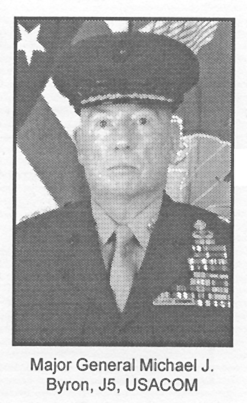 While some USACOM planners worked on fleshing out the "Jade Green" concept, others were developing a political-military plan for the USACOM Commander in Chief (CINC), Admiral Paul D. Miller. The plan would be submitted to the JCS and the National Security Council
(NSC) interagency working group for Haiti as a basis for synchronizing official cooperation for a Haitian incursion. Lieutenant Colonel Ed Donnelly, a U.S. Army officer working within the USACOM J5, wrote the weapons control portions of the political-military plan and noted that
While some USACOM planners worked on fleshing out the "Jade Green" concept, others were developing a political-military plan for the USACOM Commander in Chief (CINC), Admiral Paul D. Miller. The plan would be submitted to the JCS and the National Security Council
(NSC) interagency working group for Haiti as a basis for synchronizing official cooperation for a Haitian incursion. Lieutenant Colonel Ed Donnelly, a U.S. Army officer working within the USACOM J5, wrote the weapons control portions of the political-military plan and noted thatEssentially, USACOM put together a document that told the Interagency Working Group within the National Security Council what they would be expected to contribute to an operation in Haiti. USACOM laid out the purpose of the operation, the endstate, and defined criteria for military success. That document went to the JCS and then the NSC where it was codified. The document then came back with corrections but essentially USACOM wrote the document.40The political-military plan for Haiti was a first, according to Donnelly, because numerous government agencies and a unified command, USACOM, participated in its creation.41 The political-military plan approvedby the NSC was authoritative to all. The plan, moreover, further served to shape the Jade Green OPLAN that was rapidly coming to fruition. 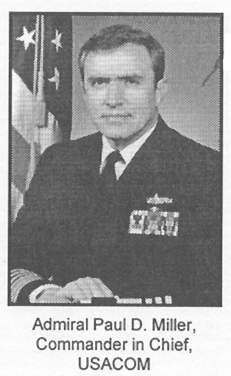 A key portion of the political-military plan centered upon Haitian security. Planners at the NSC and USACOM. believed that any military operation into Haiti must remove the FAd'H and the Haitian Police in order to establish security on the island. Removing those organizations meant either replacing them with a U.S. military force (not an acceptable option) or retraining and reestablishing the FAd'H, the Haitian Police, or both. Some type of armed force was needed to provide a stable and secure environment in which democracy could
flourish once the Haitian junta was removed and Aristide returned.
A key portion of the political-military plan centered upon Haitian security. Planners at the NSC and USACOM. believed that any military operation into Haiti must remove the FAd'H and the Haitian Police in order to establish security on the island. Removing those organizations meant either replacing them with a U.S. military force (not an acceptable option) or retraining and reestablishing the FAd'H, the Haitian Police, or both. Some type of armed force was needed to provide a stable and secure environment in which democracy could
flourish once the Haitian junta was removed and Aristide returned.Major General Byron and Lieutenant Colonel Donnelly later went to Washington, D.C., to brief selected members of the NSC interagency working group on Haiti. Byron told the group that DOD did not view training the Haitian Police as a military mission and that the Department of Justice, under the Department of State, should have the lead in developing a plan to vet and train the new Haitian police force properly (see figure 2). The interagency working group approved that concept in April 1994.42 The group farther agreed to conduct an interagency rehearsal prior to an invasion, if one occurred, to ensure that each governmental department was prepared to meet its taskings as specified in the political-military plan. The Haitian Migrant Crisis and Operation Plan 2370 In January 1994, the deadline for Cedras to step down from power came and went. France and Canada immediately urged that sanctions against Haiti increase. The United States, however, fearing a renewed flow of refugees who would seek asylum in the United States, continued its policy of repatriating fleeing Haitians. President Aristide, critical of U.S. policy, moved into thepublic eye through a series of Congressional meetings, public demonstrations, and media interviews.43 Meanwhile, on orders from the JCS, USACOM began the conceptual evolution of what would become OPLAN 2370,44 the invasion of Haiti by the 82d Airborne Division and a Joint Special Operations Task Force (JSOTF).
This compartmentalization led to coordination problems between ... planning agencies, specifically between USACOM, XVIIITh Airborne Corps, USASOC [United States Army Special Operations Command], 82d Airborne Division.... The code words and procedures used that would allow individuals to talk about the plan were not the same at [XVIIITh Airborne] Corps and USASOC. So ... parties could only stare and nod knowingly at each other.49Many plans officers who needed to be brought into a compartment because of their planning expertise were not allowed to do so because they lacked a top secret clearance. Since it can take up to six months to obtain approval for a clearance of that level, many officers who had much-needed planning skills could not participate in the planning for Haiti. Adding to the frustration was the fact that, as a matter of routine, several planning officers were scheduled to rotate to new assignments. Their replacements had to gain access to the compartment, if they met security requirements, and then spend several weeks trying to get caught up on what had transpired to date. While officers at various levels sought ways to work around the compartmented planning dilemmas, Lieutenant General Henry H. ("Hugh") Shelton, the XVIII Airborne Corps commander, mulled over the operational guidance he received from Admiral Miller. Shelton then provided Major Garrett with his own guidance that the operation would occur at night and be a forcible entry. In concept, U.S. forces would descend on Haiti in the dark and quickly secure critical targets all over the island. Once daylight approached, the average Haitian soldier or civilian would arise to discover that the Americans owned everything.50 Garrett and other XVIII Airborne Corps plans officers later presented Shelton with a mission analysis briefing. From that presentation, Shelton developed courses of action to determine the best way to accomplish the mission and selected the alternative that he thought was the most feasible and acceptable. What he selected was an option that called for eight airborne battalions to descend on Haiti--five battalions in Port-au-Prince, two north of Port-au-Prince, and one at Cap Haitien--with the intent of securing the island without firing a shot. In addition, a JSOTF would move inland and secure the countryside while searching for weapons caches. 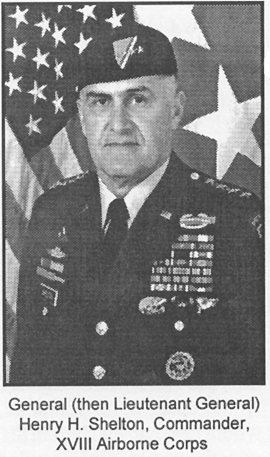 OPLAN 2370 was now coming together per the guidance and
direction of Miller and Shelton. As Lieutenant Colonel Gordon Bonham, the XVIII Airborne Corps chief of plans, noted: "The primary objectives of [OPLAN 2370] were to neutralize the FAd'H and police; to protect U.S. citizens, third country nationals, designated Haitians'
interests and property; to conduct a NEO as required; to restore civil order; to establish essential services; ... and to set the conditions for the re-establishment of the legitimate government of Haiti."51 OPLAN
2370 further required that U.S. forces would assist in the reorganization of the Haitian armed forces and the police. The XVIII Airborne Corps staff completed a draft OPLAN, received Shelton's approval, and then briefed the plan to USACOM on February 23, 1994.
OPLAN 2370 was now coming together per the guidance and
direction of Miller and Shelton. As Lieutenant Colonel Gordon Bonham, the XVIII Airborne Corps chief of plans, noted: "The primary objectives of [OPLAN 2370] were to neutralize the FAd'H and police; to protect U.S. citizens, third country nationals, designated Haitians'
interests and property; to conduct a NEO as required; to restore civil order; to establish essential services; ... and to set the conditions for the re-establishment of the legitimate government of Haiti."51 OPLAN
2370 further required that U.S. forces would assist in the reorganization of the Haitian armed forces and the police. The XVIII Airborne Corps staff completed a draft OPLAN, received Shelton's approval, and then briefed the plan to USACOM on February 23, 1994.OPLAN 2370 established a joint operations area (JOA) encompassing all of Haiti and the island of Great Inagua (see map 3). A large amount of the Caribbean west and southwest of Haiti was included in the JOA as well, together with the naval bases at Roosevelt Roads, Puerto Rico, and Guantanamo Bay, Cuba. The large JOA was designed to provide operational maneuver space for numerous invading ships and aircraft; it would also serve to establish logistical support and staging bases for the deployment of U.S. ground forces. The planners considered both friendly and enemy centers of gravity. A center of gravity, according to the great nineteenth-century Prussian military theorist, Carl von Clausewitz, is "the hub of all power and movement on which everything depends."52 Protecting one's own center of gravity while getting at the opposing center of gravity is critical to achieving success in a military operation. The XVIII Airborne Corps plans officers determined that the friendly strategic center of gravity was U.S. public support for an invasion and the political leadership's will to see it 0 through, while the operational center of gravity was control of Port-au-Prince. Conversely, the Haitian strategic center of gravity was viewed as the politico-military leadership, while the operational center of gravity was the FAd'H.53 The corps intelligence collection priorities focused on finding the location of every Haitian FAd'H and police unit down to company size on the island. It was discovered that there were nine police companies and eight FAd'H companies, some with heavy weapons, in Port-au-Prince. In addition, thirty-three other FAd'H companies and three more police companies were dispersed outside the capital in other cities around the island.54 Each company's exact location was pinpointed and, in most cases, the staff identified the unit's precise headquarters (see map 4). In addition to finding out about FAd'H and Haitian Police locations and capabilities, Shelton also wanted specific information regarding the Government Center in the capital, the status of security at Port-au-Prince International Airport, and the capabilities of a FAd'H heavy weapons company at Camp d'Application.55
The 82d Airborne Division commander, Major General William M. Steele, thought that the operation could be done in forty-five days or less. He envisioned a simultaneous airborne, air assault, and ground assault operation throughout Haiti over a six-hour period. In that the division's paratroopers were equipped with night-vision devices to assist them in the accomplishment of their mission with little or no light, the operation would take place at night. The division would take one morning to eliminate the FAd'H, seize every Haitian police station, and secure its remaining targets. 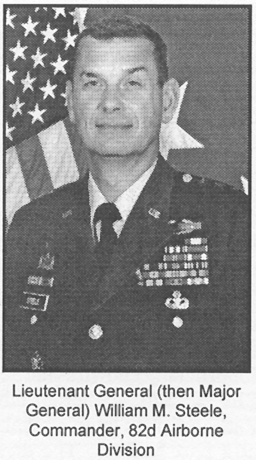 The forcible-entry operation would conceivably be executed within nine days from notification and last no longer than a few hours. The division's mission statement noted that the 82d would conduct multiple
airborne assaults onto Haiti to establish three lodgements, protect American citizens and property and designated foreign nationals, and neutralize the Haitian Armed Forces and Police. The division cominander's intent was for the division to enter quickly, secure a
lodgement, secure the island, then in six weeks hand over the operation to a follow-on force, such as the United Nations or U.S. Forces, Haiti.
The forcible-entry operation would conceivably be executed within nine days from notification and last no longer than a few hours. The division's mission statement noted that the 82d would conduct multiple
airborne assaults onto Haiti to establish three lodgements, protect American citizens and property and designated foreign nationals, and neutralize the Haitian Armed Forces and Police. The division cominander's intent was for the division to enter quickly, secure a
lodgement, secure the island, then in six weeks hand over the operation to a follow-on force, such as the United Nations or U.S. Forces, Haiti.The division anticipated securing forty D-day objectives that would require 3,848 paratroopers using 113 U.S. Air Force transports over two designated drop zones (DZ). The battalions from the 1st Brigade (unofficially known as the 504th Parachute Infantry Regiment, or 504th PIR58), 82d Airborne Division, would seize the primary DZ, Port-au-Prince International Airport, and establish a second lodgement at a port facility. The division's 2d Brigade (known as the 325th Airborne Infantry Regiment) would relieve the 1st Brigade after the airborne assault and expand the lodgement. An additional 4,500 paratroopers, to include the division artillery, would arrive by aircraft once the airport was secure. Using the airfield as a base, the artillery would then provide fire support throughout the island. Meanwhile, north of Port-au-Prince, several battalions from the 3d Brigade, or 505th PIR, would seize Pegasus, the second DZ, which would then be expanded to contain the Division Support Command, the aviation brigade assault command post, a logistics element, a security element, and eventually the division headquarters base of operations. Pegasus DZ was planned to accommodate 28,000 gallons of aviation fuel, about a twenty-four-hour supply for the division. Moreover, six M551 Sheridan tanks would also be placed in Pegasus as a reaction force to counter most Haitian FAd'H threats (see map 5).
While the 82d was concentrating on its objectives, the JSOTF would be securing parts of Port-au-Prince International Airport, the National Palace, Dessalines, Barracks, the Haitian 4th Police Company Headquarts, and Camp d'Application.61 AC-130 Spectre gunships would begin firing at designated targets in Haiti at H-hour on the morning of D-day (see map 6),62 while a forty-five-man SEAL detachment, delivered to their target by U.S. Army MH-60 helicopters, would eliminate the Haitian 4th Police Company, which controlled the roads to the National Palace. Simultaneously, approximately 265 Rangers would conduct a helicopter assault from Guantanamo Bay to Camp d'Application and eliminate the FAd'H main threat, the fifty-man heavy weapons company equipped with several V-150 Commando armored cars. Concurrently, a separate Ranger platoon would secure the U.S. Embassy. Another 480 Rangers would arrive simultaneously by helicopter to attack and secure Dessalines Barracks and the National Palace. Two SEAL teams would reinforce the Rangers at the National Palace--one after thirty minutes and the other, two hours later (see map 7). Twenty minutes after the initial H-hour attacks, 445 Rangers would parachute onto a deserted farm field west of Port-au-Prince to establish Forward Operating Base Dallas. If all went well, the plan assumed that the entire JSOTF assault would be over in less than four hours. Army Special Forces teams, meanwhile, would also be landing in Haiti, primarily to secure the countryside and search for hidden weapons caches.63
The logistical concept of support was designed to sustain the operation for several weeks. Each service would be responsible for supplying its own forces. All units would deploy with five days' supply on hand and with three days' supply as emergency backup. Supplies would stage out of four major airheads (McGuire Air Force Base [AFB], Pope AFB, Charleston AFB, and MacDilI AFB) and five intermediate staging bases (ISB) (Hunter Army Airfield; Homestead AFB; Guantanamo Bay, Cuba; Great Inagua; and Roosevelt Roads, Puerto Rico) (see map 8).
Fuel considerations consisted of ensuring that the force had 12,000 gallons on the ground for use by H+8, to be delivered by air initially, then by barge. Total D-day fuel deliveries to create a thirty-day supply included 33,600 gallons of motor gasoline (MOGAS) for selected vehicles and cooking stoves, 600,000 gallons of diesel fuel for vehicles, and 2,402,000 gallons of aviation fuel. Medical support would be provided early in the operation by surgical teams inserted with the assaulting forces. Each team could perform field surgery and had a limited capacity for air evacuation. U.S. medics would provide emergency health care to Haitians in life-threatening situations, and by D+6, U.S. medical forces were scheduled to have established a 100-bed hospital in Port-au-Prince. That hospital would be capable of surgery, ground and air evacuation, dental care, veterinary (primarily food inspection services), preventive medicine, medical logistics, and command functions. The hospital at Roosevelt Roads, Puerto Rico, would be used for evacuated soldiers who needed additional care. Medical planners would augment the JSOTF with additional medical teams, while Navy Forces (or NAVFOR, the naval forces component command, joint forces) and Marines would provide their own medical support. The Air Force would provide air evacuation to the continental United States (CONUS) or Roosevelt Roads as required, with JSOTF soldiers going to Guantanamo Bay and then to CONUS.66 Possibly the most complex aspect of the operation would be the communications linkages required for control. The primary means of communication would be by tactical satellite (TACSAT). The JTF 180 headquarters would locate itself on the USS Mount Whitney, a highly modem command and control vessel belonging to USACOM. The JTF headquarters would talk via TACSAT to an airborne command post that would then talk to USACOM in Norfolk, Virginia. Other TACSAT links were put in so that the JTF 180 commander and staff could talk to the JSOTF, ARFOR, NAVFOR, the JTF main headquarters at Fort Bragg, the JCS, and various airborne command and control aircraft within the JOA.67 On April 6,1994, while OPLAN 2370 was being framed, Aristide publicly attacked President Clinton's policy toward Haiti, using well-publicized accounts of Haitian brutality and human rights abuses to accuse the administration of a "racist policy" toward Haitians. Aristide, moreover, informed Clinton that he was issuing a six-month notice for the United States to repeal a 1981 treaty between the United States and Haiti regarding the interception of Haitians in international waters and their forcible return to Haiti. A few days later, Randall Robinson, the executive director of TransAfrica, announced he was going on a hunger strike to protest U. S. policy toward Haiti. His protest garnered strong media attention and the support of the Congressional Black, Caucus, especially when Robinson indicated that his life was now in the hands of President Clinton. Robinson ended his hunger strike in May, but only after the Clinton administration agreed to change its procedures for processing Haitian migrants. Every refugee could now make a case for asylum, while the administration also set up new immigration centers aboard the USS Comfort in Jamaica. Meanwhile, on April 15, 1994, JTF 180 was disestablished when it was believed that the Haiti invasion would no longer occur. The joint Special Operations community continued to work with the forcible-entry plan into May, just in case the crisis heated up again. A Change of Plans In late May, the JCS indicated to USACOM that it might want to consider developing another plan that envisioned a peaceful entry into Haiti instead of combat. On June 2,1994, USACOM notified the XVIII Airborne Corps to begin creating a second option, one that enabled U.S. forces to enter Haiti permissively, with a handover to a United Nations Mission in Haiti (UNMIH). The new plan deleted the neutralization of the FAd'H and Haitian Police contained in the forcible-entry option, while retaining the other missions, including the reestablishment of a legitimate Haitian government. CONPLAN (operation plan in concept format) 2380, as it was initially called, went to the JCS for review on June 17. The JCS replied to USACOM on June 29, directing that the CONPLAN be changed into an operations order (OPORD). The change from CONPLAN to OPORD caused much excitement at Fort Bragg, for as Lieutenant Colonel Bonham put it, "The word OPORD is significant in joint [military] lexicon because [it] indicates a high likelihood of execution to include a date, time for execution. The JCS directing the OPORD sent tremors through [us] and we began planning in earnest in July of 1994."68 As planning went forward, U.S. ships intercepted about 20,000 Haitian refugees at sea within the period from mid-June to early July. On June 28, Guantanamo Bay's refugee camps reopened to handle the flow of refugees. A week later, the Clinton administration announced that it would no longer allow Haitian refugees to resettle in the United States, even if qualified. The U.S. Coast Guard returned refugees to Haiti at a rate of over 600 a day.69 When word reached Haiti that refugees would no longer be allowed to move into the United States, the amount of Haitians afloat reduced significantly in numbers. The crisis, however, remained unresolved, necessitating further planning and the involvement of additional headquarters. By the summer of 1994, the XVIII Airborne Corps staff was simultaneously working with two major contingency plans for Haiti. In concept, at least, the two plans, OPLAN 2380 and OPLAN 2370, contrasted markedly on the issue of duration. As Lieutenant Colonel Bonham put it: "[OPLAN] 2380 was a much longer operation; minimum of 179 days.... For that reason, the FORSCOM Commander and the XVIIIth Airborne Corps Commander were concerned about having the key forcible entry assets, the 82d Airborne Division and our JSOTF forces, being fixed or committed for an extended period in time and not be able to react to other contingencies."70 To allay this concern, General Dennis Reimer, the FORSCOM commander and, in one of his several hats, the Army component commander for USACOM, intervened to redistribute the workload. With the concurrence of Lieutenant General Shelton, Reimer indicated that he wanted a new headquarters, the 10th Mountain Division, from Fort Drum, New York, to be given responsibility for refining OPLAN 2380. The CINC, USACOM, decided that this was the preferred course of action, so on July 29, Major General David C. Meade, Commanding General, 10th Mountain Division, along with his chief of staff, operations officer, and planners arrived at Fort Bragg to receive an OPLAN 2380 mission briefing from the XVIII Airborne Corps staff. Also present at the meeting was Major General Byron from USACOM J5. Two different headquarters were now developing two plans, simultaneously, and at two different locations. As the 10th Mountain picked up OPLAN 2380, JTF 180 continued to plan 2370, which would employ the 82d Airborne Division in the kinds of operations for which it, but not the 10th Mountain, had been specifically trained.71 As for the 10th Mountain Division, although it was subordinate to and less robust than the XVIII Airborne Corps, it was being directed to design an operation that was normally developed by a much larger headquarters.72 OPLAN 2380 At Fort Drum, the 10th Mountain Division completed an initial OPLAN 2380 concept, and Meade briefed CINC, USACOM, on August 3, 1994. As presented, the 10th Mountain Division mission included a planned noncombatant evacuation to remove U.S. citizens and other designated individuals and the return of the government of Haiti to a "proper functioning" status. Most important, 10th Mountain Division saw itself "establishing and maintaining a stable and secure environment." Conceptually, the division would "deploy forces quickly and execute rapid entry of forces; control the center of gravity (Port-au-Prince) and Cap Haitien; control the countryside using a JSOTF; return President Aristide to power; maintain the initiative; stand up a Haitian public security force; and ensure unity of effort before turning the operation over to the United Nations."73 (See map 9.)
Phase II--or deployment-initial security operations--would begin on D-day and continue through D+6. During this phase, the CJTF would establish conditions conducive to stability in Haiti. Colonel Andrew R. Berdy, with his 1st Brigade Combat Team (BCT), would conduct an air assault from helicopters off the USS Eisenhower and secure the aerial port of debarkation (APOD) and seaport of debarkation (SPOD) in Port-au-Prince. He would also establish a quick reaction force at the airfield for contingencies. The 2d BCT, commanded by Colonel Jim Dubik, would sea-land forces in Cap Haitien to seize the airfield and the port facilities. Both BCTs, together with TF Mountain, would protect key Haitian leaders and establish civil order and a security area as their D-day objectives. The CJTF 190, NAVFOR, would be in reserve, with an additional mission of conducting a noncombatant evacuation order if required.75 Phase III--extended security operations and initial civil-military operations--was to begin on D+7 and last until D+20. The plan saw a buildup of U.S. forces in the outlying areas of Haiti, an assessment of the feasibility of efforts to professionalize the FAd'H, the integration of multinational coalition forces into the operation, and the buildup of logistics. The CJTF would also establish freedom of movement within Haiti for Haitians, work with the U.S. Department of Justice's International Criminal Investigative Training Assistance Program (ICITAP) to form the Haitian Police, and continue to provide security and stability throughout Haiti.76 The next phase, Phase IV, envisioned an expansion of civil-military operations from D+21 to D+120. During this phase, the JSOTF would begin training the Haitian military. Priority would be given to civil affairs operations designed to ensure security and stability in the country. Furthermore, logistics agencies would be working contracts to prepare for the transition to the United Nations. If practical, some U.S. forces would return home during this phase. The last phase, the transition to the United Nations Mission in Haiti and the redeployment of CJTF Haiti, would occur between D+121 and D+180. During that time, UNMIH forces would arrive and accept mission responsibility from CJTF 190, civilian contractors would take over the logistics functions, and the U.S. force would return to home station.77 The plan was unique for several reasons. A large portion of the 10th Mountain Division would assault from an aircraft carrier with Army helicopter assets. The notion of lifting a light division from an aircraft carrier into a potential war zone is not something the Army routinely trains to do. It was believed, however, that by doing just that, the JTF 190 commander would gain increased flexibility by having a robust force offshore that he could send anywhere in Haiti. The OPLAN was also risky in that it used the 10th Mountain Division. That unit hadjust come out of Somalia and might now have to deploy to yet another major contingency. Although 10th Mountain Division personnel believed they were up to the task, the unit had been moving at a grueling pace for almost two years. OPLAN 2380, moreover, did not envision replacing the 10th Mountain Division for six months, and then only upon the transition to UNMIH, not to U.S. forces. The transition to UNMIH, a multinational coalition, would require much more intensive planning than turning over the same operation to another U.S. unit that shared the same doctrine, language, equipment, and methods of operation. The CINC, USACOM, approved the plan in concept and recommended that the planning continue. On August 10, the 10th Mountain Division staff completed the draft of OPLAN 2380 and conducted a full-scale operational rehearsal at Fort Drum. After some minor corrections, the division published the final plan on September 1, 1994, with change 1 being released on September 8. Tweaking OPLAN 2370 Soon after the JTF 180 planners passed OPLAN 2380 to the 10th Mountain Division, they were told that CINC, USACOM, had changed the planning guidance for OPLAN 2370. Admiral Miller told Shelton to scratch the notion of using eight airborne battalions in Haiti and to go with five battalions instead. The basis for the reduction seemed to be the CINC's new guidance that he wanted to include Marines in the invasion. Shelton joked that the next surprise would be the development of an OPLAN that merged 2370 and 2380. Time would prove just how clairvoyant he was.78 Meanwhile, in keeping with Miller's directive, the 24th Marine Expeditionary Unit (MEU) was designated as the U.S. Marine headquarters to enter Haiti. In mid-August 1994, the 24th was replaced by the 22d Marine Regiment, the 24th MEU's landing force. Shelton and his planners were not happy with the addition of the Marine unit. The JTF 180 planners believed that USACOM staff officers, in briefing their superiors, were greatly exaggerating the potential threat in Haiti to U.S. forces. According to this view, the USACOM J5 staff was arguing that airborne battalions did not have sufficient survivability if the FAd'H organized strong resistance to oppose the invasion. That possibility increased operational risks and drove the CINC to add the Marines, with their greater firepower and protection capabilities, at the expense of several airborne battalions. As Bonham put it: we felt that they [USACOM] had misrepresented us ... they misrepresented the facts to the DCINC [Deputy CINC] and he gave a briefing inaccurately [to the CINC]. [Later] they [USACOM] said "We need to go brief the CINC on your plan again so send us your briefing slides." We said, "No. If the CINC wants to know why we need those [airborne] battalions we will come up and brief the CINC." USACOM staff did not know the [OPLAN] details. So we played games, they asked for slides and we said [no] we would brief. We did that for quite a while.79Shelton eventually argued with Miller to retain the original OPLAN 2370. The general explained that he needed airborne forces to provide a rapid entry and shock action. Without eight airborne battalions, the force would become highly dependent upon capturing the airfield at Port-au-Prince and that, in itself, could slow the operation and put the force at higher risk. Miller listened, then stated: "Noted, now go develop a new plan."80 The admiral provided additional guidance that directed Shelton to ensure that the Marines were used specifically in Port-au-Prince. Miller then conceded that, should the plan be executed in less than ninety-six hours from notification, then Shelton could use eight airborne battalions. If the option was ten days out from execution, however, then five airborne battalions and the Marines would be used. The tactical objectives would be split between Port-au-Prince and Cap Haitien, with the Marines going into Port-au-Prince. Shelton returned to Fort Bragg and directed his planners to develop a new plan using Marines. On 21 July, the JTF 180 planners, together with other service planners in support of JTF 180, returned to USACOM and briefed the USACOM J3 operations officer on the new plan (see map 10). During the briefing, Miller walked in and stated, "I already know what I am going to do but go ahead and tell me what you've got."81 Every planner from every service told Miller that putting Marines into Port-au-Prince made no tactical sense. The 82d Airborne Division had already planned the operation, the airspace would be crowded, the JSOTF knew what it was doing, the potential for fratricide would be increased, and the Marines would be better off in Cap Haitien where they could logistically sustain themselves while ashore. Although Miller said nothing, the JTF 180 planners returned to Fort Bragg believing that his mind was already made up.
...we [continually] sent people upto, [Fort] Drum and vice versa. The problem was that a lot of [subordinate] planners [here] ... were trying to plan for the forcible entry piece [at Fort Bragg] while trying to plan to support the benign entry that 10th Mountain Division was working on [at Fort Drum]. I am sure they were stretched. The planning was the longest nine months of my life with my work hours going firom six in the morning until nine at night Monday through Saturday. We usually took Sunday morning off and then we would come in and work all afternoon. 83CARICOM Contingent In July 1994, USACOM received planning guidance from the JCS to develop plans to include Caribbean nations in the Haiti invasion. Initially, that task fell to Major General Byron, USACOM J5. Through coordination with the U.S. State Department, an initial meeting of several Caribbean nations and U.S. representatives was held in Puerto Rico on July 12, 1994, to discuss the need for and the possibility of creating a Caribbean task force to assist the United Nations in Haiti. Byron gave the task of developing the Caribbean Command (CARICOM) to U.S. Army Lieutenant Colonel Chris Olson, USACOM J5, about one week after he arrived in Norfolk, Virginia, after graduating from the National War College.84 Olson received guidance from Byron to "get as many flags as possible" from the Caribbean nations, even if they could only provide a platoon.85 Olson initially coordinated his mission through the State Department, which contacted embassy personnel in the respective Caribbean nations to determine the possibility of their contributing forces to a CARICOM Contingent. Once the State Department received word on which nations were interested, USACOM received permission to begin direct military-to-military discussions on how this unit would form. Byron went to Port Royal, Jamaica, on July 22, 1994, to meet with military representatives of several Caribbean nations. The purpose of the meeting was to examine the military tasks to be accomplished by a CARICOM force in Haiti once the junta departed. Byron addressed the group by first reading excerpts from a UNSCR dated July 15,1994, and then stating that "heightened UN activities" required another short-notice meeting of the Caribbean nations.86 After a detailed briefing from USACOM on the situation in Haiti, the nations of Jamaica, Trinidad and Tobago, Guyana, Bahamas, Belize, Barbados, Antigua, and Barbuda jointly agreed to provide one platoon of soldiers each. The meeting further refined mission requirements and provisions for weapons, ammunition, task organization, logistical support, and pay. CARICOM would follow the U.S. invasion force into Haiti after the country was secure. A memorandum of agreement was composed to delineate command and discipline of troops, as well as the chain of command and national lines of communication. The representatives also discussed conducting a peace operation train up in Roosevelt Roads, as well as setting each participant's minimum-required levels of expertise and service experience. Finally, the parties agreed that the force would ultimately serve under a United Nations mandate. The CARICOM Contingent would "show that seven islands around Haiti were displeased with the Cedras regime and were joining the United States to help Haiti."87 By having international "flags" committed to the operation, moreover, the invasion shifted from a unilateral U.S intervention to a United Nations-sanctioned multinational action. A final meeting of the CARICOM participants, USACOM, and the U.S. State Department on August 19, 1994, continued to work out the details of the training plan, organizational issues, logistics, and funding.88 Border Monitors While XVIII Airborne Corps and the 10th Mountain Division worked on their respective OPLANs, another situation unfolded that required U.S. Army forces. It was noted that fuel was being smuggled into Haiti from the Dominican Republic.89 In the effort to keep pressure on the Cedras junta, UN sanctions had specifically denied fuel imports into Haiti. The Haitian-Dominican border, however, was impossible to monitor without additional forces and technology. Military planners now had to figure out what exactly was needed to monitor the border for compliance with the sanctions and how this task could be best accomplished. In April 1994, the government of the Dominican Republic transmitted a message to the United Nations Security Council specifying what measures it had taken to enforce the Haitian embargo. The message also requested additional assistance in assessing what further actions might be necessary. On May 6, 1994, Dominican President Joaquin Balaguer established a high commission to oversee the Haitian-Dominican border to prevent border violations and curb smuggling. President Balaguer further requested international border monitors to ensure that the sanctions were being observed. A United Nations technical group visited the Dominican Republic during May 19-24 and concluded that Santo Domingo should "seek assistance (logistical, technical, and/or personnel) from. a friendly country or countries." The United Nations Security Council, for fear of establishing a precedent for future operations of this type, declined to provide the technical advisers. The Dominican government then asked for United States assistance. On June 1, 1994, the Joint Chiefs of Staff ordered USACOM to deploy a Technical Assistance Team (TAT) to the Dominican Republic. USACOM requested that FORSCOM provide an Army unit to conduct three tasks over three days. The tasks were (1) to assess the support requirements for a multinational observer group (MOG) to assist the Dominicans in monitoring, detecting, and reporting UNSCR 917 violations, (2) to operate with the Dominican military in identifying potential border observer sites and observer duties, and (3) to conduct an aviation maintenance assessment of the Dominican military's aviation. FORSCOM gave the TAT mission to the 1st Brigade, 7th Infantry Division (Light) (also called the 9th Infantry Regiment), based at Fort Lewis, Washington, and commanded by Colonel Willie McMillian, McMillian, who did not speak Spanish, received notification of the mission on June 4, 1994.90 McMillian's staff assembled a team of eight officers from within his brigade and six additional personnel from other government agencies for the mission. The group spent June 4-5 going over the political climate within the Dominican Republic and identifying tasks that they might have to accomplish to complete their mission. The TAT departed Fort Lewis on June 6, received additional mission guidance and information at FORSCOM, then departed for the Dominican Republic on June 8. Upon arrival in the Dominican Republic, McMillian met with U.S. Embassy personnel to coordinate for support and receive additional guidance. The TAT then deployed to five separate sites along the Haitian-Dominican border. The team spent two days examining the sites for their utility in monitoring illegal border crossings. The TAT then moved to the USS Wasp, the headquarters ship for JTF 120, which was anchored in Guantanamo Bay. The assessment team used the next two days to mull over its findings. McMillian first prebriefed Rear Admiral Abbot, Commander, JTF 120, on his appraisal, then gave a lengthier briefing to CINC, USACOM, via video telephone conference (VTC). According to one observer, McMillian, who had exhausted himself by staying awake almost seventy-two hours, did not "present the excellence that was contained in the actual [written] report." In fact, Rear Admiral Abbot had to "reassure Admiral Miller several times during the briefing that the TAT had conducted an excellent analysis and that the report would 'answer the mail.'"91 The TAT assessment noted several key findings, McMillian believed that the mission could be accomplished but would require more personnel than initially envisioned because of the lengthy border and the need for force protection. The TAT report also delineated the need for robust communications support, to include tactical satellite radios and commercial phones because of the ruggedness of the terrain and its detrimental effect upon communications signals. Logistically, the TAT noted that any mission support package would be almost as large as the unit conducting the operation. Since that kind of support was unlikely, funds would have to be found to pay for host nation provisions, contractors, and U.S. Embassy assistance, particularly in the areas of soldier services, water, food, transportation, and medical support. The aviation assessment, moreover, was grim. For instance, Dominican helicopters were rated unsafe for use by U.S. personnel. Following the briefing to Miller, the TAT briefed their findings to General Reimer at FORSCOM and then returned to Fort Lewis, where it disbanded. Those who had been members of the TAT now prepared for possible deployment to the Dominican Republic as border observers. In addition to personal preparation, they worked with the 3d Battalion, 9th Infantry--the unit designated to perform the actual border observation mission. That unit trained on weapons qualification, rules of engagement, and situational exercises that included both friendly and hostile military and civilians, reporting procedures, and sanction violation reporting. On July 2, 1994, the chairman of the JCS published an alert order with the requirement that USACOM develop a MOG order for a multinational headquarters no later than July 11, 1994. USACOM, in turn, tasked JTF 120 to provide the draft order by July 7. CINC, FORSCOM, appointed Colonel William A. McDonough, a Spanish-speaking U.S. officer, as the MOG commander, and he reported to the USS Wasp on July 12. The same day, the U.S. State Department tentatively identified MOG members from Canada, Argentina, France, and several Caribbean nations. The MOG advanced echelon (ADVON) deployed to the Dominican Republic on July 25 and began extensive preparation of the five observation sites. The United States would place forces at two sites, Peppillo Salcedo and Dajabon, while Argentina, Canada, and the Caribbean troops would control the others. Each site also had representatives from the Dominican military and police, who would react to border violations and provide local security for the observers. The MOG main body, after going through training at Fort Benning, Georgia, began arriving in the Dominican Republic on September 1. The MOG was now designated CJTF 125 and placed under the control of JTF 120. The U.S., Argentinean, Canadian, and Caribbean forces were coequal headquarters under CJTF 125. All nations went through a mission certification process before assuming their observation site duties on September 11. Each day, the teams sent situation reports on border activity to CJTF 125 headquarters, where they were collated and passed on to JTF 120. A Dominican liaison officer synchronized the site reports with his military so that they could respond to border violations as they occurred. While the MOG mission was ongoing, McDonough received a message from JTF 120 to develop a plan to pull , the MOG off the border in case Haiti was invaded. On September 17, the MOG was ordered to return to Santo Domingo, which it did without incident. The MOG remained in the Dominican capital until the sanctions on Haiti were lifted on September 26, whereupon the MOG disbanded and returned to their respective home stations. Building a Bridge While the MOG was standing up and deploying to the Dominican Republic, the United States, in late July, was persuading the UN Security Council to approve a resolution that allowed member states to force the Haitian junta to accept Aristide's return. As Robert Pastor noted, "This was a watershed event in international relations--the first time that the UN Security Council had authorized the use of force [UNSCR 940] for the purpose of restoring democracy to a member state."92 UNSCR 940 called for the "application of all necessary means" to restore democracy in Haiti and for the establishment of a multinational force for Haiti. At USACOM, planners had been watching the diplomatic traffic in earnest and now perceived that an invasion of Haiti was imminent. Consequently, they put tremendous pressure on the XVIII Airborne Corps to finalize OPLAN 2370 and on the 10th Mountain Division to finish OPLAN 2380. In a final burst of effort, both staffs completed their respective plans. On August 29, Lieutenant General William Hartzog, the USACOM Deputy CINC, briefed both plans to the JCS for approval. In early September 1994, Secretary of Defense William Perry authorized CINC, USACOM, to pre-position U.S. forces in anticipation of an operation to invade Haiti. Soon after that authorization, on Friday, September 2, JTF 180 planners, together with representatives from the 10th Mountain Division, were called to USACOM (see figure 4). The command had received recent guidance from the JCS that a new plan needed to be developed--one that would "bridge" the two OPLANs. In essence, the JCS wanted to find an option in the middle--between OPLAN 2370, with its "kick the door down" approach, and OPLAN 2380, where U.S. forces were invited guests. General Hartzog opened the new planning session by stating that "If anyone repeats this I will cut him off at the knees but I feel that we will be in Haiti within the next thirty days."93 The unit staffs began to brainstorm what the "bridge" plan would be. The XVIII Airborne Corps called the new plan OPLAN 2375.94 Shelton's offhand prediction of an OPLAN merger back in July had come to fruition. The new plan, according to Major General Meade, needed to reflect "increased flexibility and more options at the last minute than either of the two plans had separately."95 OPLAN 2375 envisioned that OPLAN 2370 would be executed initially but last only two days because of a more passive and cooperative Haitian regime that would pass from the scene rather quickly. OPLAN 2380 would then take over, with the exception that JTF 180 (the XVIII Airborne Corps) would remain in command of the operation, with JTF 190 (the 10th Mountain Division) as a subordinate headquarters. Since both OPLAN 2370 and. OPLAN 2380 were still viable options, there were now three OPLANs that needed to be continually refined and resourced for possible execution. The merged OPLAN 2375 required that command and control channels be very clear, since using pieces of two plans could cause confusion. As one Special Forces planner noted, "The most significant challenge was to ensure that SOF [Special Operations Forces] command-and-control channels remained clear during and after transition between JTF 180 and JTF 190."96
Byron and Donnelly from USACOM J5 went to the National Security Council on September 11 to attend the Haiti Interagency Working Group (IWG). The purpose of the meeting was to conduct a final walk through of the political-military plan as agreed to earlier in the year. Byron briefed the Haiti invasion concept to the entire IWG for the first time and, by doing so, brought the plan "out of the compartment." As Byron began briefing, Donnelly noted that many members of the working group stared in disbelief, not even their own people, who had known about the plan for over a year, had let the secret out. At one point, Byron turned to the Department of Justice representative to explain just how that department was going to train and equip the new Haitian Police force. The Department of Justice representative stated the department could not handle the mission. Byron immediately called USACOM, where the mission was given to Lieutenant Colonel Phil Idiart, in J5. Idiart spent the next three days working at his desk to assemble a plan to create the Interim Public Security Force and the International Police Monitors.98 The Haiti operation remained a secret despite the complications in coordinating planning activities. In the course of a year, no one in the planning compartment had leaked any information regarding Jade Green or any OPLAN variant. Once the plan was briefed to the interagency on September 11, however, the invasion concept appeared in the media within days, to include operational sketches and potential targets (see map 11).99
Also that day, the CARICOM Contingent deployed to Puerto Rico for training in peace operations, as specified in a JCS execute order of September 5.100 After the meeting in Jamaica, USACOM had issued a planning order on August 27 to coordinate the training and logistical support for the contingent. Lieutenant Colonel Olson used Special Operations Forces to visit participating Caribbean countries to identify what equipment they would need. He discovered that many of the CARICOM soldiers needed everything from canteens, to underwear, to boots. Olson spent his days making hundreds of phone calls to various U.S. equipment depots to locate the items. While doing so, he also discovered that depot personnel did not share his sense of urgency. He could not tell the inquisitive employees specifically why he needed the items because, at that level, the plan was still compartmented. Instead, Olson used his powers of persistence and persuasion to eventually get the supplies he needed. 101 It was imperative that the supplies be in Puerto Rico so that the CARICOM Contingent could begin a twenty-one-day training cycle on September 13. Olson placed Special Forces personnel at airports, seaports, and rail hubs to update him constantly where each shipment was and to notify him when the supplies arrived in Puerto Rico. Other supplies were coming from the participating nations. Special Forces troops assisted the CARICOM nations in putting their equipment on pallets according to U.S. Air Force specifications so that the items could be flown to Puerto Rico, Olson and his Special Forces "chain of informants" painstakingly tracked every shipment, and CARICOM training began on schedule. Olson noted that "MG Byron ensured that CNN covered the arrival of the CARICOM forces in Puerto Rico to play 'mind games' with Cedras."102 The CARICOM Contingent of about 300 soldiers was eventually joined by a total of twenty-five nations to create the United Nations Mission in Haiti.103 The contingent's mission was to conduct peace operations, including guarding the airport, escorting vehicles, and conducting limited security operations in selected Haitian cities. The unit was not to participate in the actual invasion but would follow the invading force at a later date. The CARICOM Contingent was placed under the command and control of the USACOM J5 until it arrived in Haiti, where it would be put under the command of the JTF 190 headquarters.104 About the same time that CARICOM was beginning its training, the JTF 180 staff raised two concerns with USACOM. The first issue was the invasion date (D-day), which USACOM had yet to establish. JTF 180's concern was that, with U.S. forces deploying, the junta would discover that the invasion was about to occur and plan accordingly. The second concern was that many U.S. units were moving to ISBs in Guantanamo Bay, as well as afloat off the coast of Haiti, with no deception plan in effect to try and confuse the Haitian government as to what was happening. Without a deception plan, the JTF 180 staff believed that Cedras and the ruling junta in Haiti would be tipped off as to the imminent invasion. Cedras might then prepare a strong defense that would cost American lives. USACOM responded to JTF 180's concerns by stating that a D-day had not yet been determined. JTF 180 planners then assumed that the invasion would occur on September 20, based upon the previously planned ten-day scenario. As far as a deception plan was concerned, Lieutenant Colonel Bonham summed it up by saying, "I don't think the higher ups ever thought about that or were much concerned about [deception] since they wanted to send a clear signal that this is your final option to get out."105 USACOM later notified JTF 180 that D-day would probably be September 19. On the evening of September 15, 1994, President Clinton addressed the nation, informing his audience that he was directing the secretary of defense to call up military reservists in support of U.S. troops in any action that might be taken in Haiti. Furthermore, he announced that he was ordering two aircraft carriers, the USS Eisenhower and the USS America, into the region. In explaining his actions, the president declared that "beyond the human rights violations, the immigration problems, the importance of democracy, the United States also has strong interests in not letting dictators, especially in our own region, break their word to the United States and the United Nations."106 The next day, President Clinton notified his subordinate military commanders that he had decided to implement the Haiti military operation. But as the military planners began to prepare to execute this mission, scheduled for the morning of September 19, fate took another twist. Cedras and the junta, which previously had shown no outward signs of responding to diplomatic signals for them to relinquish power, had contacted former President Jimmy Carter and asked for his assistance in negotiating some type of settlement. On September 17, a hastily formed negotiation team consisting of Carter, Senator Sam Nunn, and retired General Colin Powell arrived in Haiti to begin--with the permission of President Clinton--negotiations for a peaceful settlement of the crisis. On September 18, aboard the USS Mount Whitney, the command and control ship for JTF 180, the planners had just finished briefing Shelton on OPLAN 2370 and were preparing to go over OPLAN 2375, when the general inforrned the plans officers that the Carter team was going into Haiti to try and reach an agreement.107 What soon developed would test the flexibility of JTF 180's commanders and plans officers. At 1800 on the 18th, CNN announced that the Carter team was still negotiating with Cedras and the de facto government of Haiti. Soon after the CNN announcement, word was received aboard the USS Mount Whitney that the secretary of defense had just signed the execute order for OPLAN 2370. JTF 180 received a CINC, USACOM, message at 2231Z authorizing Operation Uphold Democracy, with D-day-H-hour designated as September 19, 1994, at 0401Z.108 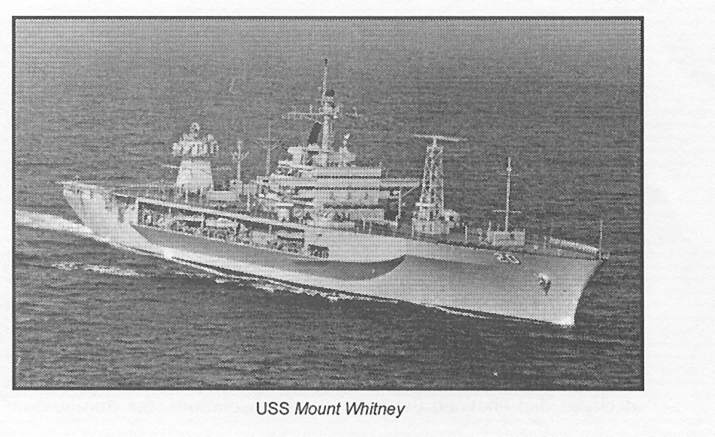 As preparations proceeded for an invasion of Haiti, rumors spread through the Joint Operations Center at USACOM that the Carter team might reach an agreement with the junta. In the meantime, Admiral Miller informed General John Shalikashvili, chairman of the Joint Chiefs of Staff, that the first C-130 aircraft were launching at 1846 and that he, Miller, needed "a call back to give me a degree of confidence so I can start this operation."109
As preparations proceeded for an invasion of Haiti, rumors spread through the Joint Operations Center at USACOM that the Carter team might reach an agreement with the junta. In the meantime, Admiral Miller informed General John Shalikashvili, chairman of the Joint Chiefs of Staff, that the first C-130 aircraft were launching at 1846 and that he, Miller, needed "a call back to give me a degree of confidence so I can start this operation."109 Admiral Miller began to think through his options. He held discussions with his watch officers over the possible use of OPLAN 2380 vice 2370 and his growing concern of how Shelton would get into Haiti and take charge from the junta. As Miller contemplated the situation, he received word that sixteen C-130s carrying paratroopers had lifted off at 1847 and were now en route to Haiti. Another group of paratroopers was scheduled to lift off at 1930. Miller then directed his transportation officer to allow those soldiers to load up, but not to lift off without his order. 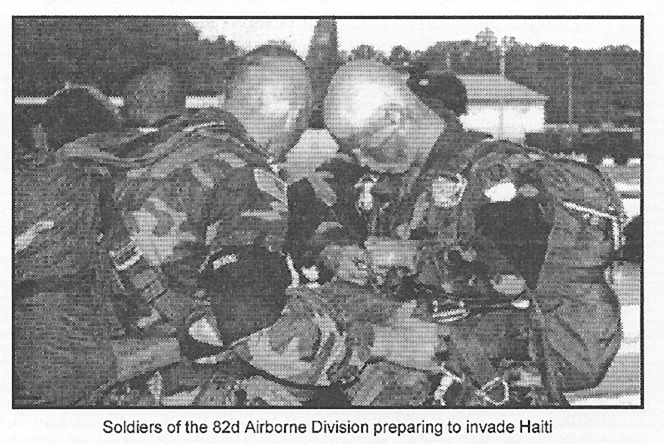 At 1922, CINC, Special Operations Command, called to let Miller know that the Army Rangers were going to lift off from Fort Stewart, Georgia, at 203O. A few minutes later, CNN announced that Carter and Cedras had met for an hour and that a motorcade had just left the embassy. Shortly thereafter, USACOM received word that Carter had reached an agreement for Cedras and his junta to leave Haiti by October 15; there would be an administrative landing of U.S. forces rather than a combat operation.
At 1922, CINC, Special Operations Command, called to let Miller know that the Army Rangers were going to lift off from Fort Stewart, Georgia, at 203O. A few minutes later, CNN announced that Carter and Cedras had met for an hour and that a motorcade had just left the embassy. Shortly thereafter, USACOM received word that Carter had reached an agreement for Cedras and his junta to leave Haiti by October 15; there would be an administrative landing of U.S. forces rather than a combat operation.Miller once again called the JCS and notified them that there were now sixty-two aircraft in the air. He further added that the mission must be canceled by 2100 or aircraft would run out of gas and have to terminate (see figure 5). The JCS, however, would not authorize aborting the mission. At 1940, Miller again called the JCS and stated that "Based upon your verbal authorization, I will put out a message to stop the flow."110 On September 18, at 2347Z, CINC, USACOM, notified JTF 180 to cease the H-hour countdown and to reset for a "possible OPLAN 2380 the next day."  With OPLAN 2370 now called off, Miller began to reassess the situation and determine what to do next. He believed that it was imperative to get U.S. forces on the ground as quickly as possible. In this vein, Shelton received word that he should expect to be meeting with the junta in the morning. Miller also contacted U.S. Ambassador William Swing in Haiti and asked for his advice. Swing stated that it would be of the utmost importance to get a large number of troops on the ground quickly. Miller told Swing that he would be "sending in Shelton early" and that he wanted to put a company on the ground "for atmosphere."111
With OPLAN 2370 now called off, Miller began to reassess the situation and determine what to do next. He believed that it was imperative to get U.S. forces on the ground as quickly as possible. In this vein, Shelton received word that he should expect to be meeting with the junta in the morning. Miller also contacted U.S. Ambassador William Swing in Haiti and asked for his advice. Swing stated that it would be of the utmost importance to get a large number of troops on the ground quickly. Miller told Swing that he would be "sending in Shelton early" and that he wanted to put a company on the ground "for atmosphere."111 An intelligence source mentioned that it would be important to bring in enough forces in case "Cedras stiffs us." Miller agreed. He wanted to ensure that a force went into Camp d'Application right away to show that it was no longer under control of the FAd'H. His operations and intelligence officers also believed that flowing in a large amount of forces quickly would reduce Haitian-versus-Haitian violence.112
The planners immediately convened at 2300. Shelton was shocked that he would be dealing directly with Cedras but agreed to meet with him at the Port-au-Prince airfield at 1000 the next morning. Shelton gave Bonham two hours to come up with an executable OPLAN based upon the "spirit" of the Carter negotiations. Bonham sat down at a chalkboard and wrote "ten o'clock meeting with Cedras" on a timeline. Bonham and the rest of the planners realized that they had less than twelve hours to come up with a new OPLAN--one that merged the three OPLANs currently in existence. He then led the staff in planning all the activities required to have security in place by the time of the meeting: an air assault to seize the airport, the securing of the port facility in Port-au-Prince, movement of harbor shipping, the flow of aircraft, and other key events. Also critical was the seizure of a FAd'H weapons cache near the airport known as "Target 27." 114 Although the new mission was released as JTF 180 Fragmentary Order (FRAGO) 35, the document became known as Uphold Democracy "2380-Plus" because it designated the force package associated with OPLAN 2380 as the main effort. The operational conditions of 2380 Plus, however, were changed from the benign entry of OPLAN 2380 to one taking place in an uncertain environment. The political events of the previous twenty-four hours had occurred so fast that no one was quite sure what to expect. OPLAN 2380 Plus noted that, while the Carter visit had succeeded, the Haitian environment remained ambiguous. No OPLAN had envisioned that the junta would not only be in power after U.S. forces arrived but that it would have to be dealt with for several weeks before Aristide returned. The order therefore stressed that U.S. forces must enter Haiti quickly, gain the trust of the Haitian people, and stabilize the population, but not in a way that could be considered as overly aggressive. U.S. forces would conduct military operations to restore and preserve civil order; protect U.S. citizens and interests and designated Haitians and third-country nationals; create a secure environrnent for the restoration of the legitimate government of Haiti; and provide technical assistance to the government of Haiti.115 OPLAN 2380 Plus, moreover, emphasized securing Camp d'Application, with its heavy weapons cache, securing Port-au-Prince airfield, and rapidly building up the U.S. military presence on the island. 116 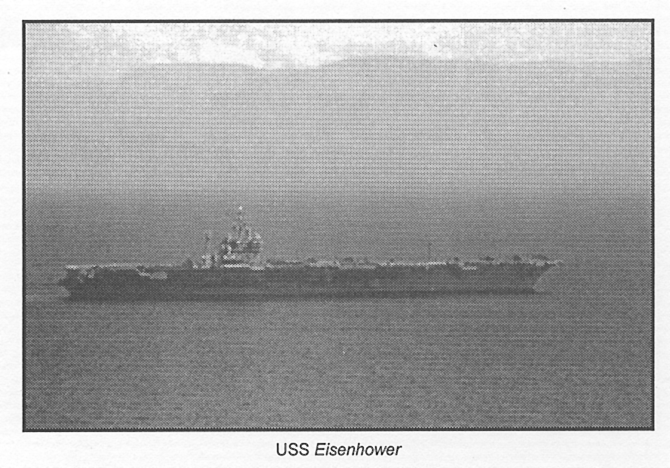 Shelton approved the 2380 Plus concept at 0100 in the morning on September 19, and by 0300, an OPORD had been issued to the appropriate forces for mission accomplishment. Just after 0900, in a scene reminiscent of the film Apocalypse Now,
U.S. Army forces arrived in Haiti via Blackhawk helicopters. As CNN cameras rolled, 10th Mountain Division soldiers, many of them veterans of Somalia, leapt from their helicopters and, with weapons at the ready, threw themselves down on the tarmac behind their rucksacks. A U.S. Embassy Army officer, wearing his summer Class B uniform, strode out to meet the camouflaged combat troops and told them to relax. Soon, Shelton arrived at Port-au-Prince International Airport, then traveled to the National Palace, where he notified Cedras that he, Shelton, was now in charge. He then began arrangements for Cedras and his fellow junta members to leave the country safely. The next step would then be to return President Aristide to office. The growing mass of 10th Mountain Division troops, meanwhile, tentatively began to move off the airport towards the Light Industrial Complex in Port-au-Prince. The second American occupation of Haiti this century was now unfolding.
Shelton approved the 2380 Plus concept at 0100 in the morning on September 19, and by 0300, an OPORD had been issued to the appropriate forces for mission accomplishment. Just after 0900, in a scene reminiscent of the film Apocalypse Now,
U.S. Army forces arrived in Haiti via Blackhawk helicopters. As CNN cameras rolled, 10th Mountain Division soldiers, many of them veterans of Somalia, leapt from their helicopters and, with weapons at the ready, threw themselves down on the tarmac behind their rucksacks. A U.S. Embassy Army officer, wearing his summer Class B uniform, strode out to meet the camouflaged combat troops and told them to relax. Soon, Shelton arrived at Port-au-Prince International Airport, then traveled to the National Palace, where he notified Cedras that he, Shelton, was now in charge. He then began arrangements for Cedras and his fellow junta members to leave the country safely. The next step would then be to return President Aristide to office. The growing mass of 10th Mountain Division troops, meanwhile, tentatively began to move off the airport towards the Light Industrial Complex in Port-au-Prince. The second American occupation of Haiti this century was now unfolding. |
|
NEWSLETTER
|
| Join the GlobalSecurity.org mailing list |
|
|
|


